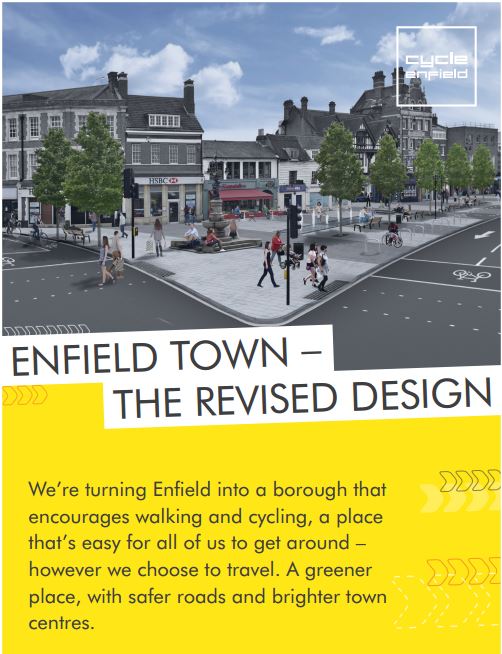
Revised Proposals and Timetable
- Summary and map on Cycle Enfield website
- January 2017: Exhibition of revised proposals and community co-design workshops for enhanced public realm
- Spring 2017: Statutory consultation to capture any final issues that may impact upon the design
Enfield Council has today revealed its revised proposals for implementing its Cycle Holland vision in the centre of Enfield Town.
The new scheme retains the existing one-way system for cars, buses and lorries (westbound along Cecil Road, eastbound along Church Street). There will be no cycle lanes along Church Street, instead lanes in both directions along Cecil Road will provide for safe through journeys by bike.
While the basic road layout for cars remains unchanged, there will be measures to soften the impact of motorised traffic on other users of the town centre: a 20mph speed limit, improved pedestrian crossings, wider pavements, a much more pedestrian-friendly route from the Library Square to Town Park and various other public realm enhancements, in particular with regard to the area in front of Enfield Town railway station.
Reversing the decision to ban private cars from Church Street has been a disappointment for Better Streets for Enfield, which campaigns for more liveable streets throughout the borough. But its members are not despondent.
"A car-free Church Street would have been wonderful"
Clare Rogers from Better Streets for Enfield thinks that a car-free Church Street would have been wonderful, "boosting the local economy by making the high street a much more pleasant place to be". As a cyclist, Clare is disappointed that when travelling east-west it will still be necessary to make a diversion along Cecil Road. But, she says, "this new design is not the end of the world - there is a lot here to reassure us that Enfield Town IS getting serious improvements that could reduce the number of car journeys by encouraging more walking and cycling."
Among these improvements Clare lists more space for pedestrians in Church Street, new disabled parking bays, full segregation by planting for cycle lanes on the north side of Cecil Road, fully segregated cycle lanes on London Road and connectivity between the new cycleways and proposed Greenway routes.
"No one can now say the Council are bulldozing their plans through"
"And," Clare points out, "no one can say now that the Council are bulldozing their plans through despite public opposition. The public apparently wanted to keep their cars on Church Street, and that's what they've got. It won't be as good for business as a car-free Church Street, but there we go. My hope is that in a few years' time, when there has been more of a shift away from car travel in Enfield due to some great cycling infrastructure, there will be more public support for a car-free high street. We could push for some car-free Sundays in the town centre in the meantime, and demonstrate to people how much better it would be. So maybe this is a two-stage process that will take longer than we thought. I guess Holland wasn't built in a day."



